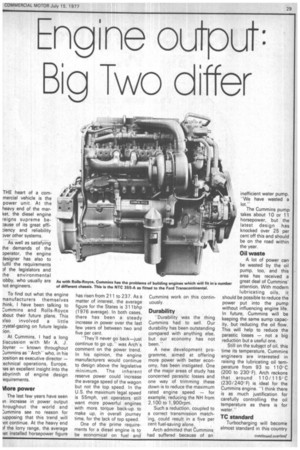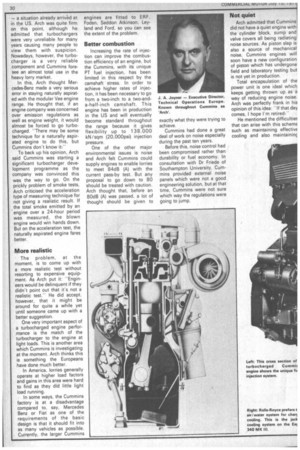Engine out out: 31g Two a ffer
Page 31

Page 32

Page 33

If you've noticed an error in this article please click here to report it so we can fix it.
THE heart of a commercial vehicle is the power unit. At the heavy end of the market, the diesel engine reigns supreme because of its great effiiency and reliability )ver other systems.
As well as satisfying the demands of the aperator, the engine iesigner has also to Fulfil the requirements af the legislators and he environmental obby, who usually are not engineers.
To find out what the engine manufacturers themselves think, I have been talking to .".:ummins and Rolls-Royce 3bout their future plans. This 3Iso involved a little rystal-gazing on future legisla:ion.
At Cummins, I had a long iiscussion with Mr A. J. Joyner — known throughout :ummins as "Arch" who, in his yosition as executive director — echnical operations, Europe, as an excellent insight into the abyrinth of engine design equirements.
Vlore power
The last few years have seen in increase in power output hroughout the world and :ummins see no reason for ;upposing that this trend will lot continue. At the heavy end yf the lorry range, the average let installed horsepower figure has risen from 211 to 237. Asa matter of interest, the average figure for the States is 311bhp (1976 average). In both cases, there has been a steady increase in power over the last few years of between two and five per cent.
"They'll never go back—just continue to go up," was Arch's comment on the power trend. In his opinion, the engine manufacturers would continue to design above the legislative Minimum. The inherent reserve power could increase the average speed of the wagon but not the top speed. In the U.S. the maximum legal speed is 55mph, yet operators still want more powerful engines with more, torque back-up to make up, in overall journey time, for the lack of top speed.
One of the prime requirements for a diesel engine is to be economical on fuel and Cummins work on this continuously.
Durability
"Durability was the thing Cummins had to sell. Our durability has been outstanding compared with anything else, but our economy has not been."
A new development programme. aimed at offering more power with better economy, has been instigated. One of the major areas of study has concerned parasitic losses and one way of trimming these down is to reduce the maximum rated engine speed -for example, reducing the NH from 2,100 to 1,900rpm.
Such a reduction, coupled to a correct transmission matching, could result in a five per cent fuel-saving alone.
Arch admitted that Cummins, had suffered because of an inefficient water pump. "We have wasted a lot."
The Cummins pump takes about 10 or 11 horsepower, but the latest design has knocked over 25 per cent off this and should be on the road within the year.
Oil waste
A lot of power can be wasted by the oil pump, too, and this area has received a great deal of Cummins' attention. With modern lubricating oils, it should be possible to reduce the power put into the pump without influencing engine life. In future, Cummins will be keeping the same sump capacity, but reducing the oil flow. This will help to reduce the parastic losses — not a big reduction but a useful one.
Still on the subject of oil, this time its temperature, Cummins engineers are interested in raising the lubricating oil temperature from 93 to 110=C (200 to 230F). Arch reckons that around 110/115C (230/240"F) is ideal for the Cum.mins engine. "I think there is as much justification for carefully controlling the oil temperature as there is for water."
TC standard Turbocharging will become almost -standard in this-country
-a situation already arrived at in the US. Arch was quite firm on this point, although he admitted that turbochargers were very unreliable for many years causing many people to view them with suspicion.
Nowadays, however, the turbocharger is a very reliable component and Cummins foresee an almost total use in the heavy lorry market.
In this, Arch thought Mercedes-Benz made a very serious error in staying naturally aspirat ed with the modular Vee engine range. He thought that, if an engine company was concerned over emission regulations as well as engine weight, it would almost be forced to go turbocharged. "There may be some. technique for a naturally aspirated engine to do this, but Cummins don't know it" To back up his opinion, Arch said Cummins was starting a significant turbocharger deve lopment programme as the company was convinced this was the way to go. On the prickly problem of smoke tests, Arch criticised the acceleration type of measuring technique for not giving a realistic result. If the total smoke emitted by an engine over a 24-hour period was measured, the blown engine would win hands down.
But on the acceleration test, the naturally aspirated engine fares better.
More realistic
The problem, at the moment, is to come up with a more realistic test without resorting to expensive equipment. As Arch put it: "Engin
eers would be delinquent if they didn't point out that it's, not a realistic test.He did accept, however, that it might be around for quite a while yet until someone came up with a better suggestion.
One very important aspect of a turbocharged engine performance is the match of the turbocharger to the engine at light loads. This is another area which Cummins is investigating at the moment. Arch thinks this is something the Europeans have done much better.
In America, lorries generally operate at higher load factors and gains in this area were hard to find as they did little light load running.
In some ways, the Cummins factory is at a disadvantage compared to, say, Mercedes Benz or Fiat as one of the requirements of the basic design is that it should fit into as many vehicles as possible. Currently, the larger Cummins engines are fitted to ERF, Foden, Seddon Atkinson, Leyland and Ford, so you can see the extent of the problem
Better combustion
Increasing the rate of injection can improve the combustion efficiency of an engine, but the Cummins, with its unique PT fuel injection, has been limited in this respect by the camshaft stress. In order to achieve higher rates of injection, it has been necessary to go from a two-inch to a two-anda-half-inch camshaft. This engine has been in production in the US and will eventually • become standard throughout the range because it gives flexibility up to 138,000 kN /sqm (20,000psi) injection pressure.
One of the other major environmental issues is noise and Arch felt Cummins could supply engines to enable lorries to meet 84dB (A) with the current pass-by test. But any proposal to go down to 80 should be treated with caution. Arch thought that, before an 80d5 (A) was passed, a lot of thought should be given to exactly what they were trying to achieve.
Cummins had done a great deal of work on noise especially during the past ten years.
Before this, noise control had been compromised rather than durability or fuel economy. In consultation with Dr Friede of Southampton University, Cummins provided external noise panels which were not a good engineering solution, but at that time, Cummins were not sure which way the regulations were going to jump.
Not quiet
Arch admitted that Cummins did not have a quiet engine with the cylinder block, sump and valve covers all being radiating noise sources. As piston slap is also a source of mechanical noise, Cummins engines will soon have a new configuration of piston which has undergone field and laboratory testing but is not yet in production.
Total encapsulation of the power unit is one ideal which keeps getting thrown up as a way of reducing engine noise. Arch was perfectly frank in his opinion of this. idea: "If that day comes, I hope I'm retired:
He mentioned the difficultieE that can arise with this scheme such as maintaining effectivE cooling and also maintaininc he totality of the encapsulaion. On the second point, one .light "leak" in the encapsulaion acts as a noise source and he whole purpose is defeated and for starters you need a vay to get the transmission hrough . . .
Cummins carried out tests long these lines by encapsu)ting the big K engine, but ost-wise and service-wise it would not be very practical.
'tie' waste
Arch summed up the exercise 'ery succinctly: "We could do
but where would it leave the idustry in terms of hauling -eight? You can waste a lot of Jel on environmental protecon — it has increased the U.S. Jel bill by around 10 per cent.
Some of the legislators should be strung up!'" Temperature-controlled fans were praised by Arch who thought operators should consider them, strongly, for reasons of noise and economy. Cummins had found in testing that the fuel-saving resulting from such a fan was the equivalent of around 17bhp, but as the standard fan only absorbed around 15bhp, they were a little mystified about where the extra saving had come from. It transpired that, with the fan switched off, the oil and water temperature had stayed up and reduced the parasitic losses.
Arch was very enthusiastic about increasing the coolant temperature of his engines. Cummins now run at a top tank temperature of 93:C (200.' F), but he saw no reason why the engine should not operate at 102= C (215 F) coolant out.
Cummins have run engines at 121= C (250' F) in power plants with no problems. The real stumbling block was the lack of availability of a reliable pressure cap.
At Shrewsbury, I spoke to Brian Leverton, director and chief engineer of Rolls-Royce Motors diesel division. As with Cummins, we discussed future power requirements and the effect of environmental considerations on engine design.
Confident
Brian was doubtful about any further trends towards increasing engine output. He felt confident that a figure of around 198kW (265bhp) was about right for a 32-tonner. Main problem with higher output engines, as he sees it, is that they can be driven harder to the detriment of fuel economy — in effect the old argument that, if there is power available, the driver will always make maximum use of it. "I feel it is wrong to overpower." About 71/2 horsepower per ton is the optimum, with a little bit to spare.
Rolls-Royce's concept of engine design has tended to concentrate on useable torque rather than absolute power. As I found when I tested a 265L in a Seddon Atkinson for CM. recently, there is a different driving technique to be learned. Rolls-Royce is certainly very conscious of this point. As Brian said: "Whatever we do with the torque rise, we have to do in conjunction with driver re-education."
With high torque rise engines, it is most important to get the gearing right. This has improved over the last few years with engineers trying to by much more scientific. At Shrewsbury, the R-R development crew have a Scammell Crusader which they use as a mobile test bed for trying different rating of engines, gearboxes, axles, etc.
Torque rise
Brian thinks an engine is' needed where the torque increases as the speed drops — it does not just hang on. "Then we can go back to six-speed gearboxes behind high torque rise engines." There is always the problem, of course, that you can't put the torque rise up, too much, because you would run out of gearboxes.
With the 265 series of engines, the "standard" version produces its maximum




























































































